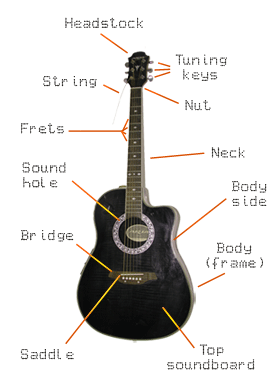Articles → Parts of a guitarParts of a guitarYou don’t have to know what the parts are called in order to play a guitar, but it can be helpful in finding your way around the instrument. 
On the picture you can see what the main parts of a guitar are called: and here’s what else you need to know. The two main parts of a guitar are the neck (a shaft with frets) and the body (box, resonance chamber, frame). The end of the neck is called the headstock, and it holds the keys which are used to fasten and tighten the strings. There are two types of headstocks – open (shown in the diagram) and closed. Classical guitars have a closed headstock, while modern guitars have an open one. The latter are more user-friendly. Electric guitars only ever have open headstocks. Below the headstock is the working part of the neck with frets that are numbered from the head towards the body. An open string (one not held down by any fingers) is numbered 0. Very often certain frets are identified by inlaid marks (white dots, for example) to make fingering easier, as well as for decoration. The body is that part of the guitar that moulds the guitar’s sound, so it is very important to look after it. A small crack anywhere in the body can seriously worsen the instrument’s sound. The body is made up of a top soundboard, the back and the body side, which is the curved panel surrounding the guitar. The top soundboard has a small opening, the sound hole, which is where most of the sound comes out. The bridge (or string support) is attached a little below the sound hole and, like the headstock, can be of two types. The classical guitar uses knots and pegs, while modern guitars use a button and loop method. With this latter method metal rings at the ends of the strings and plastic buttons are used for fastening the strings to the bridge.
Anton Gavzov |
||
|
|
||